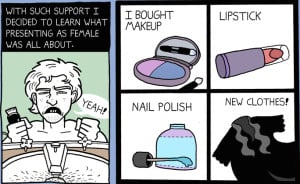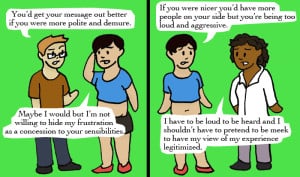
Closeup of person with red hair and glasses applying red lipstick.
I remember being full of nerves that morning on my first day at work after my gender transition. I’d been waiting for this day for a very long time. I had woken up two hours early to get ready, making sure my makeup was perfect and my dress was ironed.
At the time, my job as a bank teller required me to be on my feet for 8 hours every day. So, as I slipped on my heels, I made sure to pack flats as well. While walking down the stairs to my car, I quickly re-evaluated and concluded the heels weren’t a good idea after all — I ditched them in the car.
Out of all my memories of my first day, that’s the one that always sticks with me. Though I had spent plenty of time as my true self before my work transition, I couldn’t help but be nervous about a full day at work.
Would my customers give me a hard time? Would my coworkers misgender me by accident? Was I dressing appropriately? These were the thoughts running through my head during my first commute in a dress.
The sad truth is that too many trans people never experience a first day as their true selves. Whether they’re afraid of being fired, or worried about not getting taken seriously at work, many trans people decide to wait for retirement to transition.
Unemployment runs rampant in the trans community and trans women of color are hit the hardest; they are four times more likely to be unemployed than the general population and twice as likely as their white trans counterparts. But, with proper resources and support, there’s no reason why trans people can’t be an integral and productive member of any work team.
As I shucked my heels for more practical flats, I thought about the day ahead of me. Here were my 3 biggest worries on my first day at work:
1. Did we miss anything in planning?
My workplace transition took 4 months of planning. When I first came out to my company’s head of HR, she had a total deer in the highlights look. I could tell that she didn’t know how to support a transition. I was the company guinea pig for gender transitions.
I was also incredibly lucky that HR took my transition seriously. The HR director called several of her professional contacts to see if anyone else had administered a transition before. Their universal answer? “We haven’t, but please let us know how it goes!”
HR ended up administering diversity training sessions with a focus on common trans workplace issues to all management. Additionally, we had an evening question and answer session at the branch I was transferring to that ended up a great team building activity.
As part of my transition, I decided that a transfer to a new office where none of our customers knew me from before would be best. It’s an option that’s definitely not available to even a majority of trans people, but I felt like just being “the new girl” in the office would be easier than explaining to the customers who knew me for years that I have a new name and pronouns now.
But despite all the training and planning, how would that translate into my everyday experience? It was still possible that a customer would clock me as trans and take issue with it. It’s all well and good to plan but you know what they say about the best-laid plans of mice and men.
Judging by the experiences of my trans friends, institutional HR support varies depending on the company. While some employers, like mine, take a comprehensive approach to employee transitions, others may take a more hands-off approach or even display outright hostility.
Refusing to facilitate a gender transition could potentially land an employer in court, though a recent Department of Justice memo on Title VII sex protections for trans people leaves that outcome up in the air, despite plenty of legal precedences.
2. Will my coworkers fully accept me?
I was coming into an unfamiliar office with new social dynamics in a new gender. One thing that a lot of trans people can struggle with is gendered social cues. Lacking a cis female socialization, I was worried I would do or say something out of place or inappropriate.
A week before starting at the new branch, we held an after-work pizza meeting that was the first time my coworkers had seen me as Katelyn and it had gone really well. The culture where I live and work in Maine is also a place where most people take a “live and let live” approach to everyday life.
But even so, everyone brings preconceived opinions to work with them. Even with a fully supportive HR department, I was worried about how these subconscious biases may creep into my work life.
As a result, for the first few months, I took special care with my makeup and appearance. It felt like my appearance, work ethic, and mannerisms were the only things I had complete control of when it came to making an impression on my coworkers.
But once freed of my gender dysphoria, I became a much more productive worker and the work ethic took care of itself. Despite becoming a much more efficient worker, however, I became acutely aware of the loss of whatever male privilege I had before transitioning.
Employers are responsible for managing a diverse workplace, and increasingly those workplaces include trans people. It’s important that trans employees are allowed the opportunity to lead productive and fully integrated lives and that includes the workplace.
Currently, the unemployment rate for trans women is so high because employers and co-workers create hostile work environments and trans people still struggle to find legal recourse. As such, it’s critical that HR departments take necessary steps to train their staffs on trans discrimination.
3. How do I handle being treated as the woman I always knew myself to be?
It took less than an hour to experience overt misogyny. Of course, I knew it would happen eventually, but not with my first male customer.
He had a simple question on his account and I began explaining what was happening as I had many times before and he suddenly cut me off and asked for a supervisor. I’d seen it happen before with the numerous past female coworkers, but it was jarring nonetheless.
Looking back on it now, having personally experienced hundreds of acts of misogyny since transitioning, that one sticks out to me.
It wasn’t my first; I’d been groped in previous excursions as my female self. But it was a glimpse into my future where misogyny is now a constant drumbeat.
***
With proper planning and training, trans people can become integral and productive workers.
According to a recent study, the relief from gender dysphoria alone frees up a lot of mental capacity to simply perform better and should be reason enough for employers to manage gender transitions smoothly and thoroughly.
In the end, I survived my first day and learned that my fears were, for the most part, unwarranted.
I did learn that women’s clothes are much less insulated than men’s (I shivered most of that October day in my dress and cardigan) but, beyond that, it was a good day — flats and all.
[do_widget id=’text-101′]
Katelyn Burns is an Everyday Feminism Reporting Fellow. Katelyn is a freelance journalist and trans woman. She has previous bylines for The Washington Post, The Establishment, and VICE, among others. She lives in Maine with her two young children. Read her other articles here.
Search our 3000+ articles!
Read our articles about:
Our online racial justice training
Used by hundreds of universities, non-profits, and businesses.
Click to learn more




















